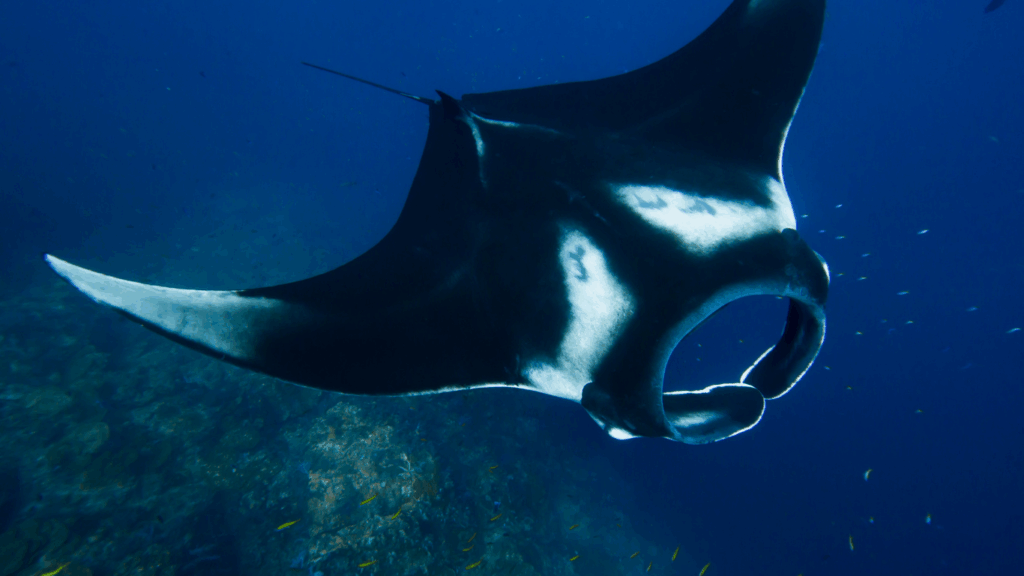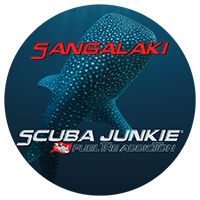
The Derawan Archipelago is more than just a diving destination — it’s a biodiversity hotspot pulsing with fascinating marine life. This second part of our marine encounters series takes a deeper dive into what makes this region so special: the animal behaviors, research efforts, and underwater moments that elevate diving here into something unforgettable.
From manta rays and whale sharks to hidden critters and baby sharks, this is where adventure meets insight.
One of the most fascinating marine life in the Derawan Archipelago is the manta ray. These filter-feeding giants glide through the shallows around Sangalaki Island and beyond, feeding on plankton and occasionally stopping at cleaning stations where smaller fish nibble away parasites from their bodies.
But here’s where it gets nerdy (and cool): each manta ray has a unique set of spots on the underside of its body — permanent patterns that scientists use like fingerprints to track individuals. Researchers from the Marine Megafauna Foundation (MMF) are currently working in Derawan to study these rays using photo-identification techniques.
Each photograph helps scientists monitor behavior, movement, and habitat use across the region. This research is vital in protecting mantas from threats like overfishing and habitat degradation.
📖 Want to learn more? Visit MMF’s Manta Ray Research page
The whale shark (Rhincodon typus) is the largest fish in the ocean, reaching lengths of up to 12 meters. Despite their size, these gentle giants are completely harmless to humans — filter-feeding on plankton, small fish, and shrimp by sucking in water and straining food through their gill rakers.
In the Derawan Archipelago, whale sharks are often spotted near local fishing platforms where they gather to snack on baitfish. While these tours aren’t part of our dive trips, they are operated by local fishermen and can be arranged once you’re on Derawan Island, depending on season and conditions.
These animals are migratory and long-lived — and sadly, they’re listed as Endangered by the IUCN. Protecting them means understanding where they go, how they live, and how human activities impact them.
Diving in the Derawan Archipelago means you’re in for diverse shark encounters. Each island has something unique:
But one of the most meaningful sights? Juvenile sharks cruising in protected, shallow bays. These areas are what we call shark nurseries — coastal environments where young sharks can grow safely.
A nursery is defined by three main criteria:
By diving respectfully in these areas, we help safeguard the future of sharks — one juvenile at a time.
Macro diving is all about finding small fascinating marine life, often camouflaged marine life that’s easy to miss if you’re not looking closely. It’s about tuning in to the reef and discovering the richness within each square meter.
Derawan Island is one of the best places in Indonesia for macro diving. From cephalopods to flatworms, tiny shrimp, and colorful nudibranchs — the reef here holds secrets that even experienced divers miss at first glance.
Nudibranchs, for example, are soft-bodied sea slugs that breathe through external gills. Many have evolved to showcase bold colors and patterns to warn predators of their toxicity. Their incredible variety (over 3,000 species known!) makes them a favorite among underwater photographers.
Our dive guides are trained to spot the smallest movement or shape change — but the real joy is when you find something. Macro diving is part observation, part puzzle-solving — and entirely addictive.
Turtles are everywhere in the Derawan Archipelago. From green turtles (Chelonia mydas) to the critically endangered hawksbills (Eretmochelys imbricata), these ancient mariners are a near-daily sight during dives, often resting on coral, grazing on seagrass, or swimming beside you in the blue.
We’ve teamed up with the Marine Megafauna Foundation to start building a turtle photo-ID database. Each turtle can be identified by the unique pattern of facial scales — just like a fingerprint.
Guests are invited to participate by submitting clear, side-profile photos taken during their dives. This helps researchers monitor turtle populations, track their movements, and understand how best to protect them from threats like marine debris, fishing nets, and habitat loss.
Why it matters:
💡 Tip: Always keep at least 3 meters of distance, never chase or touch, and let them approach you on their own.
One of the most endearing sights in Derawan happens right at the water’s edge. At sunset, our team leads gentle shoreline walks where you might spot baby guitar sharks (family Rhinobatidae) swimming just meters from the beach.
Why are they there? These shallow, warm waters offer a safe haven from larger predators, an abundance of crustaceans to feed on, and a quiet space to grow.
Guitar sharks are a unique evolutionary blend of sharks and rays — with flattened heads, ray-like bodies, and shark-like tails. They’re critically endangered, making each sighting not only memorable but meaningful for conservation.
The fascinating marine life of the Derawan Archipelago isn’t just something to admire — it’s something to understand. From behavior to biology, from feeding to breeding, the more we know, the better we protect.
Join us in exploring — and learning from — the reefs of Derawan. Whether it’s contributing photos to science or spotting something new on a night dive, your journey here matters.

